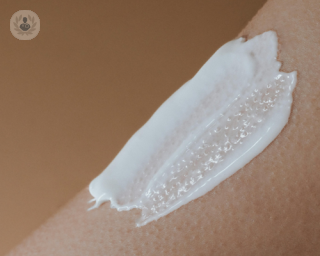Allergic dermatitis
Dr Mugilan Anandarajan - Paediatrics
Created on: 10-14-2015
Updated on: 07-07-2023
Edited by: Aoife Maguire
What is allergic dermatitis?
Allergic dermatitis is a skin condition that appears in people with allergies and can often be hereditary. It often appears during the first months of life in the form of redness or crust on the baby's skin, with pruritus (intense itching). It’s important to get a correct diagnosis.

What symptoms does allergic dermatitis provoke?
Allergic dermatitis can manifest as redness on the skin, intense itching, especially in particular parts such as the face, hands, genital area, legs, feet, crease of the elbow and knees. These symptoms appear when the skin has been in contact with the allergen also if it’s ingested.
Other signs and symptoms of contact dermatitis can include:
- Blisters, bumps, oozie and crusting.
- Burning, tenderness and swelling.
What causes allergic dermatitis?
Many substances can cause such reactions such as certain foods, such as egg, cow's milk, or corn. It cosmetics, soaps, fragrances, jewelry and plants.
Other common irritants include:
- Solvents
- Rubbing alcohol
- Detergents and bleach
- Shampoos
- Airborne substances, wool dust and saw dust
- Plants
- Pesticides and fertilisers
Why is myofascial pain produced?
Allergies manifest when the body detects an external threat, thus the immune system reacts to defend the body. The causes of allergies are unknown, although it is quite often hereditary.
Can it be prevented?
If you know what causes your allergic dermatitis, you can avoid symptoms by avoiding the allergy in question.
General preventions steps include:
- Avoiding allergens and irritants.
- Washing your skin.
- Wearing gloves or protective clothing.
- Apply an iron-on patch to cover metal fasteners (for example, zips) to avoid a reaction on your skin.
What are your treatment options?
The treatment for allergic dermatitis are based on allergic reaction you may experience. To alleviate symptoms, normally you’d have to use specific creams or oral medications.
Examples include:
- Ointments or steroid creams – Ointments or applied creams can usually soothe the rash. Depending on the instructions given by your doctor, often a topical steroid may be applied one or two times a day for two to four weeks.
- Oral medications – In severe cases, your doctor may prescribe antihistamines, oral corticosteroids to reduce inflammation, antihistamines to relieve itching, antibiotics to fight a bacterial infection.
A rash can usually clear up after two to roughly two to four weeks. You can try soothing your skin with a wet compress, anti-itch creams and other self-care steps.
What type of specialist can offer assistance with treating allergic dermatitis?
For guidance in treating allergic dermatitis you may like to book an appointment with an allergist. You may need to list some of your symptoms, how long they’ve lasted and make notes of any substances that cause you to have an allergic reaction.







